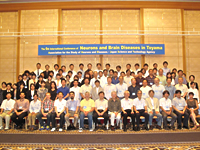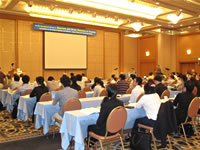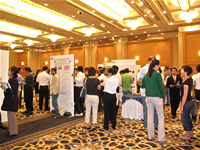


A joint international symposium, the "International Conference of Neurons and Brain Diseases", was held over three days, from August 3 through 5, at the ANA Crown Plaza Hotel Toyama. It was presided over by Chairman Inokuchi and co-sponsored by the Association for the study of Neurons and Disease (AND).
The symposium themes consisted of two JST/CREST research areas, with research topics in the areas listed below:
1."Creation of a Novel Technology towards Diagnosis and Treatment Based on Understanding of Molecular Pathogenesis of Psychiatric and Neurological Disorders"
Research topics:
1)"Development of PTSD remedy based on the molecular mechanisms underlying fear memory formation" (the research representative was Kaoru Inokuchi, Professor in the Graduate School of Medicine and Pharmacology Research Division, Toyama University)
2)"Elucidation of endophenotype of psychiatric disorders with genetically modified mice" (the research representative was Tsuyoshi Miyakawa, Professor at the Institute for Comprehensive Medical Science, Fujita Health University)
2."Elucidation of the Principles of Formation and Function of the Brain Neural Network and Creation of Control Technologies"
Research topic:
"Elucidation of the molecular basis of signaling cascades underlying plastic neuronal circuits via development of new probing and control technologies"(the research representative was Haruhiko Bito, Associate Professor at the Graduate School of Medicine and Faculty Medicine, University of Tokyo)
Currently, these three research groups of JST/CREST are leading the world in their respective research areas. At this symposium, a variety of research areas, from the basic level of molecules, cells and the whole body to medical studies related to the areas, were discussed, with 47 speeches and 49 poster presentations delivered. Moreover, the number of researchers from foreign research institutes exceeded 40, making the symposium a very international congregation.
The five JST topics of "The Mechanism of Memory", "Memory and Disorders", "Cognitive Function Disorders and Their Mechanisms", "Neuronal Circuits", and "Neuronal Plasticity" were set for this symposium, during which the most recent 23 research results were verbally presented. A total of twelve researchers, seven from the Inokuchi group, two from the Miyakawa group, and three from the Bito group, gave verbal presentations. In the JST session, world-renowned researchers, including Dr. Graham Collingridge, Dr. Bong-Kiun Kaang, Dr. Eric Klann, Dr. Kwangwook Cho, Dr. Young Rao, Dr. Guosong Liu, Dr. Ilya Bezporozvanny, Prof. Hisashi Mori, Dr. June-Seek Chio, Dr. Wei-Yang Lu, and Dr. Vadim Bolshakov delivered lectures. In addition, Dr. Min Zhuo, Dr. Michael Salter, Prof. Makoto Tominaga, Dr. John MacDonald, Prof. Seiji Ito, Prof. Terumasa Nakatsuka, Dr. Justin Lee, Prof. Masaaki Tsuda, Dr. Tuck Wah Soong, and Dr. Eunjoon Kim also delivered lectures outside of the JST session.
Each verbal presentation took twenty minutes in total, and was comprised of a fifteen minute presentation followed by a five minute question and answer session. Though the fifteen minute presentations were rather short for an international symposium, because all the researchers were experienced, they efficiently packed their presentations into the fifteen minutes, and most of them attracted our attention throughout their impressive presentations. Most of the question and answer sessions lasted longer than five minutes, and even during the coffee break between the sessions, enthusiastic discussions could be heard. As for the poster presentations, active discussions developed within a slightly tense yet comfortable atmosphere. Many poster presentations were also delivered by post-graduate students, for some of whom it was their first experience of using English for a presentation. Being exposed to an international environment seems to have been a good experience for them. On the whole, the congregation turned out to be a significant international symposium, in terms of quality and the number of participants, given the substantial exchange of information. There was a magnificent party held on the evening of the third day of the symposium, with many participants invited, and this helped them to construct a network.
One of the purposes of this joint symposium was to present the research activities of JST/CREST to the global society. At the beginning of the session, the activities of JST were described by Mr. Osamu Ichimaru of JST.
The symposium was highly praised by many of the participants, and ended successfully. May this international symposium serve as a trigger for the advancement of world-leading research efforts and an even deeper exchange of information with overseas research institutes.
JST, an integrated organization of science and technology in Japan, establishes an infrastructure for the entire process from the creation of knowledge to the return to the society. For more information, visit http://www.jst.go.jp/EN/